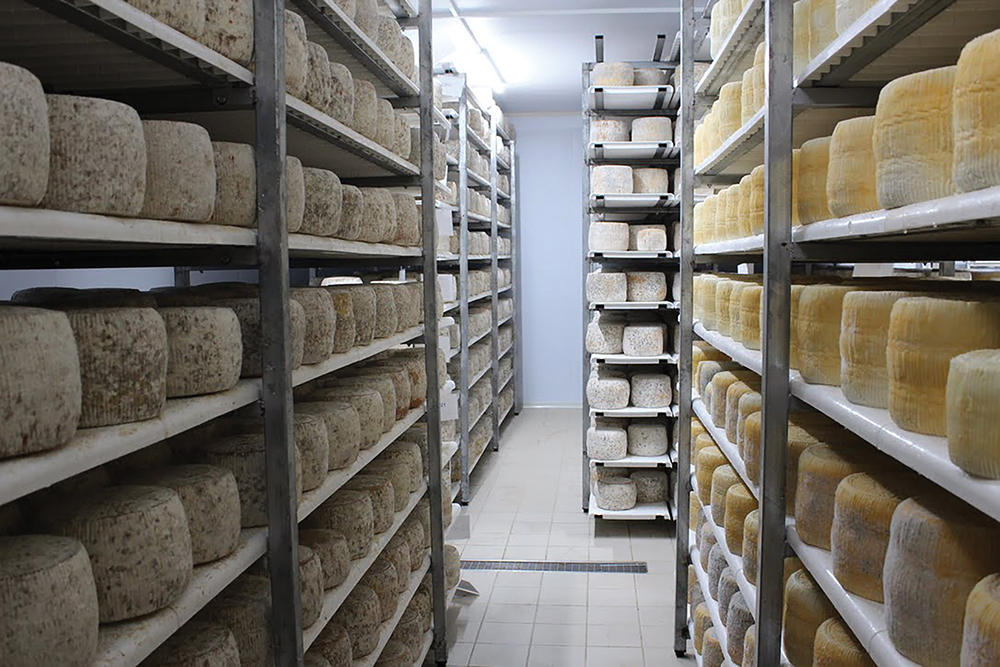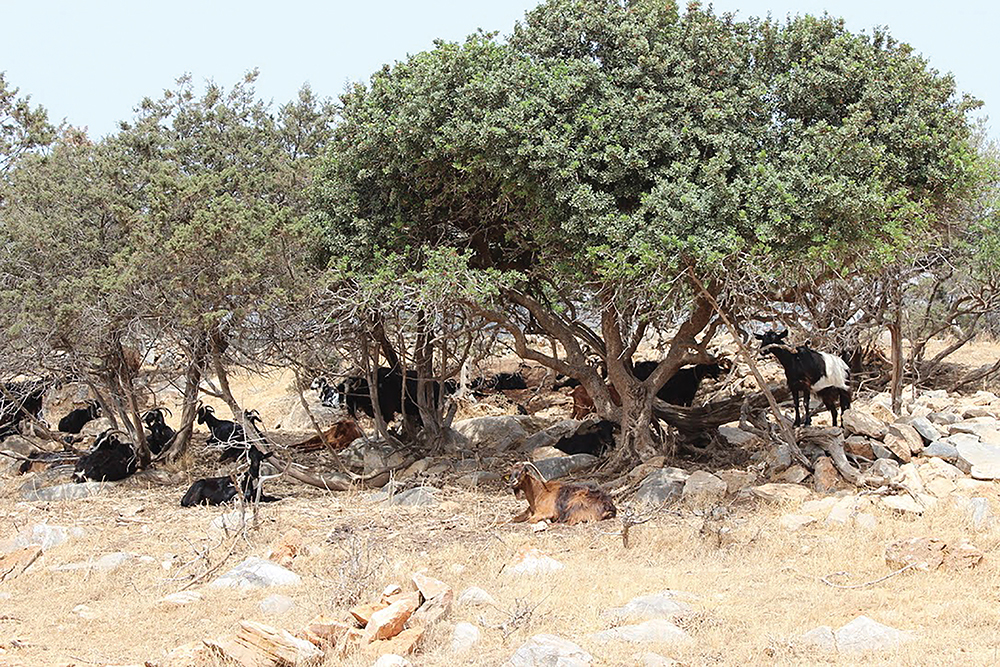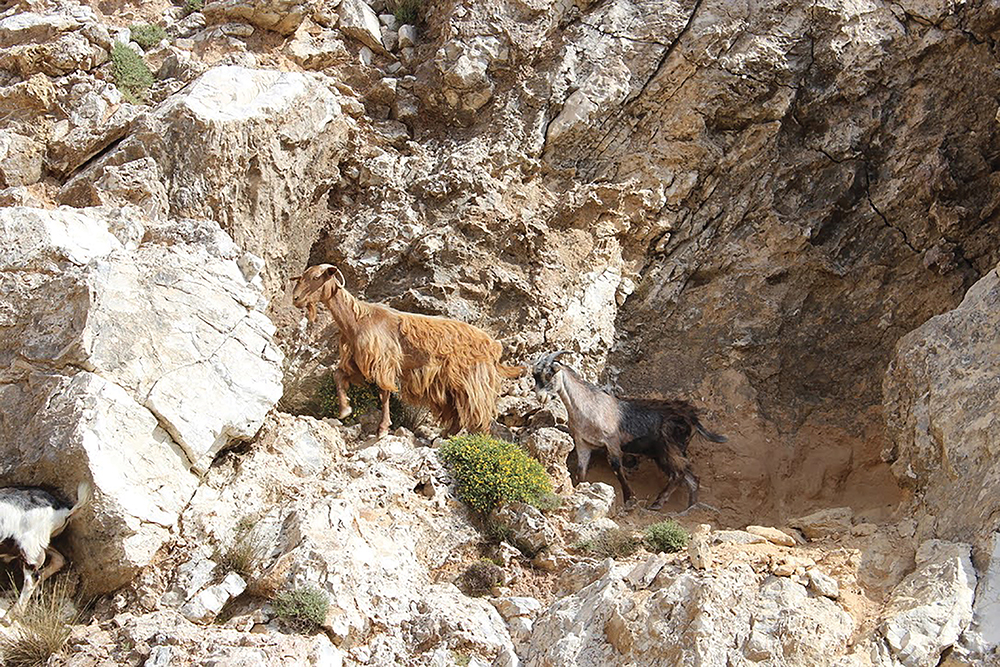
From shepherding to production, Arseniko Naxou PDO and other island cheeses are made by hand
Photographed by Margarita Gokun Silver
Ask Greeks about their country’s cheesemaking history and they might refer you to Homer’s Odyssey, in which the mention of cheese involves a shepherd, a Cyclops cheesemaker, and a cave with curd made from sheep’s and goat’s milk. Ask Naxians the same question about their island and they might mention a legend which claims that Apollo left his son Aristaeus, the god of shepherds, beekeeping, and cheesemaking, on Naxos to teach the islanders the art of cheesemaking. But go closer to the source and speak to a Naxian cheesemaker and they’ll recount how their great-grandfather started the family’s business with just a few animals, and how today they’re continuing it by making one of the island’s most celebrated cheeses.
The largest island in the Cyclades archipelago, Naxos is located about a four-hour ferry ride or a one-hour flight from Athens. While its glitzy cousins Santorini and Mykonos are famous for their sweeping vistas, dramatic sunsets, and exciting nightlife, Naxos has a reputation for self-sufficiency; with a long history of living from the land, the island could sustain itself without any imports. Today agriculture provides about 60 percent of the island’s income and employs more than half of its inhabitants. Of those, more than one-third are involved in animal husbandry, taking care of the island’s approximately 7,000 cows and shepherding close to 150,000 free-roaming goats and sheep.
Many of the shepherds and their flocks are concentrated around the traditional villages established in the ninth century by migrants from Crete. Because the Cretans who came to Naxos were traditionally involved in livestock production, and because several of the settlements they found were in the rain shadow of Mount Zas (Zeus)—rendering it too dry for agriculture—animal husbandry thrived there. Obscured from the sea, the area provided a shield from pirates while the local phrygana, the Mediterranean heathland full of species-rich plant communities, offered the perfect grazing environment. “Goat production, goat herding has a long history in this part of Naxos,” says Dr. Johannes Foufopoulos, an associate professor at the University of Michigan School for Environment and Sustainability who has done ecological research on the island. “People identify as goat herders—it’s not, ‘Hey I’m just doing a job,’ it’s, ‘This is who I am.’”


That identity often encompasses cheesemaker. “Everyone on Naxos knows how to make cheese,” one of the islanders tells me. While today—with most of the coastal population engaged in tourism—it might be an exaggeration, cheesemaking is in the island’s DNA. To make cheese in the past, villagers convened in their local cheesemaker’s μαζωμός (mazomos), a shack-like, low-ceiling dwelling whose name derived from the Greek word μαζεύω meaning “to gather.” Milk contributed by those who owned livestock but didn’t have the equipment to make their own curd was measured, and the amount of cheese every family got at the end of the week was calculated. Cheesemakers were often paid with cheese, which they later exchanged for other goods or sold at a local λαϊκή (laiki), farmer’s market.

Today many of those cheesemakers’ descendants produce the curd that sells beyond the island and often abroad. I meet one of them, third-generation cheesemaker Stefanos Liofagou Maeras, who makes his Arseniko Naxou in the old mazomos just outside the village of Filoti. Synonymous with the word “cheese” for many Naxians, Arseniko is made from unpasteurized goat’s and sheep’s milk and gets its name from the Greek word for “masculine,” a reference to its strong and piquant flavor. Maeras uses 60 percent sheep’s and 40 percent goat’s milk—in proportion with his herd—and prepares his Arseniko in the 100-year-old stainless-steel cauldron his grandfather used. He adds rennet to the fresh milk and stirs it with a wooden stick until the mixture thickens into kernel-size curd pieces. He then packs the cheese by hand into plastic molds, rubbing it with salt the next day to dry it. Maeras ages his Arseniko in the basement of his house in Filoti, sometimes brushing it with the olive oil from his own olive trees—an aging process that adds complexity to the cheese’s taste and a black, paraffin-like casing to its skin. Because Arseniko is made from raw milk, it needs to be aged at least three months, but Stefanos often keeps it for longer. The older Arseniko is, the sharper and spicier its taste—and the higher its value.
With only about 200 animals, Maeras is one of the island’s smaller producers. Despite his relatively modest production, he has chosen to obtain the Protected Destination of Origin (PDO) certification for his Arseniko. A recent phenomenon—PDO for Arseniko Naxou was granted by the EU in 2020—it’s an opportunity several of the island’s cheesemakers have embraced. To have the PDO means more than just the ability to export the cheese to other European countries; for some cheesemakers, like the Babounis family, it also means growing awareness of their cheeses. “We are interested in making the product more recognizable on the Greek market,” says Manolis Babounis, a third-generation cheesemaker who, with his son, George—the fourth generation—became the first on the island to apply for and receive the PDO for Arseniko. “[Later] the goal is to develop older versions of the cheese [to] show its true character,” he adds. The Babounis family’s animals—about 1,000 heads in all—graze on the sea-mist-swept phrygana of the Agiassos Bay and often drink seawater, which, according to Manolis Babounis, adds to the complexity of the cheese’s taste. International judges must agree: the family has won several awards for their Arseniko, the most recent a Bronze at the 2021 World Cheese Awards.
Where to stay and eat on Naxos
- For a couple’s trip, check into Naxian on the Beach, a 10-suite boutique hotel located only a few steps away from a quieter section of the island’s famous Plaka Beach. With its views of the Aegean, its proximity to the sea, and its own comfortable sun beds, this small refuge away from crowds offers suites that feature an indoor or outdoor jacuzzi. To see what a Greek salad tastes like with Naxian xynomizithra instead of feta, order it at the beach bar/restaurant Tortuga. NAXIANONTHEBEACH.COM
- If you are traveling as a family, consider staying at Naxian’s sister hotel, the Naxian Collection. Less than a five-minute drive to the beach and built in the traditional Cycladic style, the hotel is a collection of suites and villas with fully equipped kitchens and private or semi-private pools for late-evening swims. HOTEL.NAXIANCOLLECTION.COM
- For excellent fresh fish, taverna-style dishes, and a plate of local cheeses, try Paradiso, the taverna known to locals and visitors alike since 1978. Take a table on the beach under the canopy of a large tree (no shoes necessary), and be sure to try one of their desserts, conceived and created by Evdokia, the owner’s wife. PARADISONAXOS.GR
- In town go to Meze2—where saganaki is topped with citron spoon sweets, a fruit preserve made from citron rinds. While there, also try a cocktail with citron liquor produced on the island, and a potato salad made with Naxos potatoes, considered one of Greece’s best. MEZE-MEZE.NAXOSFOOD.GR
- If visiting Naxos traditional settlements, stop in Apeiranthos, one of the villages established by the Cretans, and order loukoumades— Greek donuts served with honey—in Samarathiko, a local café with a terrace that offers sweeping views of the island’s mountain range.
Receiving PDO for Arseniko Naxou is meant to provide shepherds with added value they otherwise wouldn’t get from their dairy production. Selling Arseniko isn’t allowed without certification, and for those shepherds who have yet to get the PDO, that means living off sales of the milk. I meet one of them—Giorgios Manios—at his mazomos near the summit of Mount Zas, which sits about 1,000 meters above sea level. The views are dizzying, but it’s not the vistas that Manios is most proud off. At 70 he is still working—intent on following in the footsteps of his father, who worked until he was 100. Every morning, with his son and grandson, he milks the family’s goats by hand. With about 700 animals in his care, Manios would like to expand into producing cheese rather than selling the milk to a larger cheese producer, but the mazomos—which he built himself—doesn’t have electricity or running water; using a gas tank to heat the milk, he makes small amounts of cheese for the family. Although Arseniko is normally produced between November and April and I visit in June, he offers me a demonstration of his cheesemaking skills. From pouring the fresh milk into the cauldron to adding rennet to stirring the mixture and then packing the curds into molds, the process is done entirely by hand. “Our production is traditional,” Manios says, “Not industrial.”


In addition to Arseniko, the island’s cheesemakers produce other kinds of cheeses. Both Manios and Maeras make mizithra—a white, soft cheese with a creamy texture. Prepared immediately following Arseniko by adding fresh milk to the remaining whey and then heating the mixture, glykomizithra—a sweet mizithra—is a favorite of children who eat it with bread for breakfast or with watermelon as a snack. When aged, glykomizithra turns into what Naxians refer to as thiliko, a semi-hard or hard white cheese with a slightly salty and nutty flavor. With its name derived from the Greek word for “feminine,” thiliko is milder and contains less fat than the “masculine” Arseniko, from the remnants of which it has been produced.
While glykomizithra and Arseniko are made during the winter months, xynomizithra—the sour mizithra—is usually a warmer weather special. Made with full-fat goat’s and sheep’s milk instead of whey, xynomizithra has a pleasant sour taste and is often served by Naxos chefs as a feta substitute in salads. Xynotiro is aged xynomizithra; with its stronger flavor and hard, flaky texture it’s most often grated over a dish of pasta or a casserole. It’s the cheese Iouliani Polykretis—a yiayia, or grandmother, chef extraordinaire who cooked with Anthony Bourdain in 2015, and who offers cooking classes at the small organic farm she owns with her husband Stathis—uses to sprinkle over kayiana, a Peloponnese dish of scrambled eggs with tomatoes.
I’ve been invited to cook with Polykretis, and because I’m on the island to explore all things curd, she’s planned the menu accordingly—the first dish we will be making is saganaki. A popular Greek meze (appetizer), saganaki is pan-seared cheese usually made by drenching the cheese in flour and then frying it in olive oil until tender on the inside but crispy and golden on the outside. Different kinds of cheese can be used for saganaki, but Iouliani has chosen Graviera Naxou—another Naxian cheese and one of the three Greek Gravieras with PDO certification. Often thought of as Greece’s Gruyère, Graviera is a yellow table cheese that’s popular with cheesemakers throughout the country, though its contents—and therefore its taste—vary from region to region. Graviera Naxou contains about 80 percent cow’s milk and 20 percent sheep’s and/or goat’s milk and is admired for its mild, buttery taste; Some shop owners say it’s a bestseller among tourists.
The Graviera Polykretis is frying is made by Nikolas Pittaras, a family friend and another local cheesemaker. Most at home when he talks about his cheese and the cows that produce it, Nikolas took over the family’s dairy production from his father who started it in 1970—the year Nikolas was born—with just one cow. It was Nikolas who, after 38 years of producing milk and selling it to another cheesemaker, steered the family business into cheese production in 2008. “I wanted to make the whole circle of production myself,” he explains. The circle he refers to begins with the feed—to ensure his 200 dairy cows get non-GMO feed, Pittaras grows and produces his own—and ends in labeling, packaging, and selling the cheese. “Every part of this work is part of my soul,” he says. He isn’t the only Naxian cheesemaker to express that sentiment. Continuing the island’s long history of making cheese—a history that might have begun with the Cyclops, the Aristaeus, or both—Naxos cheesemakers pay homage to the traditions and identity that have thrived there for centuries.





